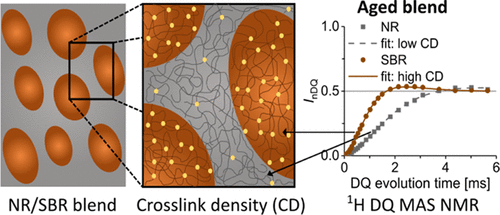当前位置:
X-MOL 学术
›
Macromolecules
›
论文详情
Our official English website, www.x-mol.net, welcomes your feedback! (Note: you will need to create a separate account there.)
NMR Studies on the Phase-Resolved Evolution of Cross-Link Densities in Thermo-Oxidatively Aged Elastomer Blends
Macromolecules ( IF 5.5 ) Pub Date : 2020-12-03 , DOI: 10.1021/acs.macromol.0c01614 Akshay Karekar 1 , Katja Oßwald 2 , Katrin Reincke 2 , Beate Langer 2, 3 , Kay Saalwächter 1
Macromolecules ( IF 5.5 ) Pub Date : 2020-12-03 , DOI: 10.1021/acs.macromol.0c01614 Akshay Karekar 1 , Katja Oßwald 2 , Katrin Reincke 2 , Beate Langer 2, 3 , Kay Saalwächter 1
Affiliation

|
A knowledge of the distribution of cross-link densities (CDs) in the constituent rubber phases of an elastomer blend is essential to understand its overall service properties, but phase-resolved CD estimations have so far been limited to qualitative assessments. In a first study of its kind, we demonstrate a phase-resolved quantification of the CDs in sulfur-cured blends of natural rubber (NR) and styrene–butadiene rubber (SBR) using solid-state 1H homonuclear dipolar double-quantum (DQ) magic-angle spinning (MAS) NMR spectroscopy. The blends were also subjected to prolonged thermo-oxidative aging to monitor the chemical changes in the two phases. Analyses of the residual dipolar coupling constant (Dres), arising due to spatial restrictions by cross-links to molecular motions, as observed in MAS and static 1H DQ experiments, suggest that unaged NR and SBR cross-link to similar extents. A minimum in Dres after around 500 h of aging duration is observed in NR, associated with the formation of highly mobile defect fractions, as seen from free induction decay (FID) combined with transverse relaxometry, with further cross-linking up to 1000 h. SBR appears more stable, with a gradual increase in Dres over the aging duration. Phase-resolved experiments reveal a somewhat less cross-linked SBR phase in an unaged 50:50 blend. The phase-specific distribution of CDs in the blend phases becomes significant upon aging, which suggests that NR ages more strongly in the blend as compared to the aged single vulcanisates, thus dictating the blend properties.
中文翻译:

核磁共振研究热氧化老化弹性体共混物中交联密度的相分辨演化
了解弹性体共混物的组成橡胶相中交联密度(CD)的分布对于了解其整体使用性能至关重要,但是迄今为止,相分辨的CD估算仅限于定性评估。在此类研究中,我们证明了使用固态1 H同核双极双量子(DQ )对天然橡胶(NR)和丁苯橡胶(SBR)的硫磺硫化共混物中的CD进行相分辨定量分析)魔角旋转(MAS)NMR光谱。还对混合物进行了长时间的热氧化老化,以监测两相中的化学变化。剩余偶极耦合常数(D res)的分析)是由于在MAS和静态1 H DQ实验中观察到的分子运动交联引起的空间限制所致,表明未老化的NR和SBR交联程度相似。从NR观察到,经过大约500小时的老化时间后,D res最小,这与高迁移缺陷分数的形成有关,从自由感应衰减(FID)结合横向弛豫法可以看出,进一步交联长达1000 h 。SBR看起来更稳定,D res逐渐增加在老化期间。相分辨实验表明,在未老化的50:50混合物中,SBR相的交联性较小。混合相中CD的特定于相的分布在老化后变得很重要,这表明与老化的单个硫化橡胶相比,混合物中的NR老化更强烈,从而决定了混合性能。
更新日期:2020-12-22
中文翻译:

核磁共振研究热氧化老化弹性体共混物中交联密度的相分辨演化
了解弹性体共混物的组成橡胶相中交联密度(CD)的分布对于了解其整体使用性能至关重要,但是迄今为止,相分辨的CD估算仅限于定性评估。在此类研究中,我们证明了使用固态1 H同核双极双量子(DQ )对天然橡胶(NR)和丁苯橡胶(SBR)的硫磺硫化共混物中的CD进行相分辨定量分析)魔角旋转(MAS)NMR光谱。还对混合物进行了长时间的热氧化老化,以监测两相中的化学变化。剩余偶极耦合常数(D res)的分析)是由于在MAS和静态1 H DQ实验中观察到的分子运动交联引起的空间限制所致,表明未老化的NR和SBR交联程度相似。从NR观察到,经过大约500小时的老化时间后,D res最小,这与高迁移缺陷分数的形成有关,从自由感应衰减(FID)结合横向弛豫法可以看出,进一步交联长达1000 h 。SBR看起来更稳定,D res逐渐增加在老化期间。相分辨实验表明,在未老化的50:50混合物中,SBR相的交联性较小。混合相中CD的特定于相的分布在老化后变得很重要,这表明与老化的单个硫化橡胶相比,混合物中的NR老化更强烈,从而决定了混合性能。


























 京公网安备 11010802027423号
京公网安备 11010802027423号